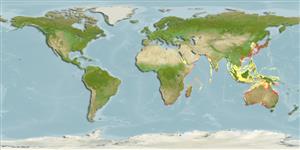Common names from other countries
Environment: milieu / climate zone / depth range / distribution range
Ecologia
marinhas; estuarina bentopelágico; oceanódromo (Ref. 51243). Tropical; 40°N - 39°S, 18°E - 155°E
Indo-West Pacific: African southeast coast from Cape of Good Hope to southern Mozambique; northern Indian Ocean off Pakistan and northwest coast of India; northern Pacific from southern Korea and Japan, along the Chinese coast to Hong Kong; in Australia along the entire southern seaboard from North West Cape (north of Shark Bay) in Western Australia to the Burnett River (north of Brisbane) in Queensland.
Comprimento de primeira maturação / Tamanho / Peso / Idade
Maturity: Lm 100.0 range ? - ? cm
Max length : 181 cm TL macho/indeterminado; (Ref. 11025); peso máx. publicado: 75.0 kg (Ref. 11025)
Espinhos dorsais (total) : 10 - 11; Raios dorsais (total) : 25 - 30; Espinhos anais: 2; Raios anais : 7; Vértebras: 25. In life, silvery grey becoming darker above and lighter below. Dorsal surface with a bluish bronze sheen that may become coppery on head. Preserved specimens vary in color according to treatment; usually grey but sometimes brown; darker above and lighter below (Ref 11025).
Adult fish found mainly near shore beyond the surf zone, occasionally going inshore. Juveniles exclusively found inshore. Juveniles recruit to estuaries at about 30 cm TL. An important food fish (Ref. 11025).
Griffiths, M.H. and P.C. Heemstra, 1995. A contribution to the taxonomy of the marine fish genus Argyrosomus (Perciformes: Sciaenidae), with descriptions of two new species from southern Africa. Ichthyol. Bull., J.L.B. Smith Inst. Ichthyol. No. 65, 40 p. (Ref. 11025)
Status na Lista Vermelha da UICN (Ref. 130435)
CITES (Ref. 128078)
Not Evaluated
Ameaça para os humanos
Harmless
Uso pelos humanos
Pescarias: espécies comerciais; Aquacultura: espécies comerciais; peixe esportivo: sim
Ferramentas
Relatórios especiais
Baixar XML
Fontes da internet
Estimates based on models
Preferred temperature (Ref.
115969): 16.7 - 27.8, mean 25.3 (based on 600 cells).
Índice de diversidade filogenética (Ref.
82804): PD
50 = 0.5020 [Uniqueness, from 0.5 = low to 2.0 = high].
Bayesian length-weight: a=0.00977 (0.00536 - 0.01781), b=3.07 (2.92 - 3.22), in cm Total Length, based on LWR estimates for this species & (Sub)family-body (Ref.
93245).
Nível Trófico (Ref.
69278): 4.5 ±0.6 se; based on diet studies.
Resiliência (Ref.
120179): Baixo, tempo mínimo de duplicação da população 4,5 - 14 anos (tm=6; tmax=40; K=0.03-0.24; Fec=900,000-1 million).
Prior r = 0.30, 95% CL = 0.20 - 0.45, Based on 1 full stock assessment.
Fishing Vulnerability (Ref.
59153): High to very high vulnerability (66 of 100).
